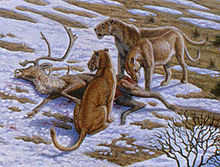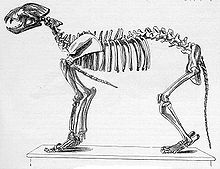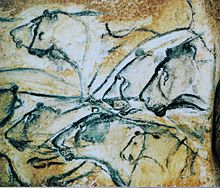- Panthera leo spelaea
-
Panthera leo spelaea
Temporal range: Middle to Late PleistoceneSkull Scientific classification Kingdom: Animalia Phylum: Chordata Class: Mammalia Order: Carnivora Family: Felidae Genus: Panthera Species: P. leo Subspecies: †P. l. spelaea Trinomial name Panthera leo spelaea
Goldfuss, 1810Panthera leo spelaea also known as the European or Eurasian cave lion, is an extinct subspecies of lion known from fossils and many examples of prehistoric art.
Contents
Physical characteristics
This subspecies was one of the largest lions. The skeleton of an adult male, which was found in 1985 near Siegsdorf (Germany), had a shoulder height of around 1.2 m (4 ft) and a head-body length of 2.1 m (7 ft) without the tail. This is similar to the size of a very large modern lion. The size of this male has been exceeded by other specimens of this subspecies. Therefore this cat may have been around 8%-10% bigger than modern lions and smaller than the earlier cave lion subspecies Panthera leo fossilis or the relatively huge American lion (Panthera atrox).[1] The cave lion is known from Paleolithic cave paintings, ivory carvings, and clay figurines. These representations indicate that cave lions had rounded, protruding ears, tufted tails, possibly faint tiger-like stripes, and that at least some had a "ruff" or primitive mane around their neck, indicating males. Other archaeological artifacts indicate that they were featured in Paleolithic religious rituals.
Environment
 Restoration by Heinrich Harder
Restoration by Heinrich Harder
The cave lion received its common name because large quantities of its remains are found in caves [2], but it is doubtful whether they lived in them. It had a wide habitat tolerance, but probably preferred conifer forests and grasslands [3], where medium-sized to large herbivores occurred. Fossil footprints of lions, which were found together with those of reindeer, demonstrate that lions once occurred even in subpolar climates. The presence of fully articulated adult cave lion skeletons, deep in cave bear dens, indicates that lions may have occasionally entered dens to prey on hibernating cave bears, with some dying in the attempt.[4]
These active carnivores [2] probably preyed upon the large herbivorous animals of their time, including horses, deer, reindeer, bison and even injured old or young mammoths. Some paintings of them in caves show several hunting together, which suggests the hunting strategy of contemporary lionesses.
Cave lions in the Chauvet Cave, France
Small prey was usually brought down with a blow of the front paw and then held down with both front feet. The animal was finally killed by a powerful bite of the sharp teeth [5], at the back of the neck, in the region of the throat and even in the chest. A cave lion usually could not run as fast as its prey, but could pounce on it from behind or run up next to it and bring it down with the paws. In this manner a running animal's balance could very easily be disturbed.
It was most likely the most common predator (after the cave hyena) in plains ecosystems.[citation needed] Its extinction may have been related to the Quaternary extinction event, which wiped out most of the megafauna prey in those regions.[citation needed] Cave paintings and remains found in the refuse piles of ancient camp sites indicate that they were hunted by early humans, which also may have contributed to their demise.[citation needed]
Classification
The cave lion is sometimes considered a species in its own right, under the name Panthera spelaea[6], and at least one authority, based on a comparison of skull shapes, considers the cave lion to be more closely related to the tiger, which would result in the formal name Panthera tigris spelaea.[7] However, recent genetic research shows that it was a close relative of the modern lion [8] and that it formed a single population with the Beringian cave lion, which has been sometimes considered as to represent a distinct form. Therefore the cave lion ranged from Europe to Alaska over the Bering land bridge until the latest Pleistocene. However it is still not completely clear, whether it was a subspecies of the lion or rather a very close relative[9]
History and distribution
 Cave lions with a reindeer by Mauricio Antón
Cave lions with a reindeer by Mauricio Antón
The cave lion (Panthera leo spelea) was derived from the earlier Panthera leo fossilis, which first appeared in Europe about 700,000 years ago. The cave lion itself lived from 370,000 to 10,000 years ago, during the Pleistocene epoch. Apparently, it became extinct about 12,500 C-14 years ago [9][dead link], during the Würm glaciation, although there are some indications it may have existed into historic times in southeastern Europe, as recently as 2,000 years ago in the Balkans.[10]
Cave lions were widespread in parts of Europe and Asia, from Great Britain, Germany and Spain (Arduini & Teruzzi, 1993) all the way to the Bering Strait and from Siberia to Turkistan.[11]
See also
- Panthera leo
- Cave lion
- Panthera leo fossilis
- Panthera leo vereshchagini
- Panthera leo atrox
- European lion
References
- ^ W. v. Koenigswald: Lebendige Eiszeit. Theiss-Verlag, 2002. ISBN 3-8062-1734-3
- ^ a b Arduini, P. & Teruzzi, G. 1993. The MacDonald encyclopedia of fossils. Little, Brown and Company, London. 320pp.
- ^ Hublin, J.-J. 1984. The Hamlyn encyclopedia of prehistoric animals. Hamlyn, London. 318pp.
- ^ 15TH INTERNATIONAL CAVE BEAR SYMPOSIUM SPIŠSKÁ NOVÁ VES, SLOVAKIA, 17th – 20th of September 2009
- ^ Lessem, D. 1999. Dinosaurs to dodos. An encyclopedia of extinct animals. Scholastic, New York. 122pp.
- ^ Christiansen, Per (December 2008): "Phylogeny of the great cats (Felidae: Pantherinae), and the influence of fossil taxa and missing characters" Cladistics Vol.24, Nu.6,pp. 977-992(16)
- ^ Groiss, J. Th. (1996): Der Höhlentiger Panthera tigris spelaea (Goldfuss). Neues Jahrb. Geol. Paläont. Mh. Vol.7, p.399–414.
- ^ Burger, Joachim et al. (2004): Molecular phylogeny of the extinct cave lion Panthera leo spelaea. Mol. Phylogenet. Evol. Vol.30, p.841-849.
- ^ a b Barnett, Ross et al. (2009): [1] (PDF)Phylogeography of lions (Panthera leo ssp.) reveals three distinct taxa and a late Pleistocene reduction in genetic diversity Mol. Ecol. Vol.18, p.1668-1677.
- ^ Wild cats of the world by C A W Guggisberg (1975) ISBN 0800883241 and Pleistocene mammals of Europe by Björn Kurtén (1968) [not seen]
- ^ 'Supersize' lions roamed Britain BBC News 1 April 2009
External links
- Prehistoric cats and prehistoric cat-like creatures, from the Messybeast Cat Resource Archive.
- American lion, by C. R. Harrington, from Yukon Beringia Interpretative Center.
- The mammoth and the flood, volume 5, chapter 1, by Hans Krause.
- Hoyle and cavetigers, from the Dinosaur Mailing List. (Groiss)
- The Interaction of the European Cave Lion and Primitive Humans
Categories:- Lions
- Prehistoric felines
- Extinct carnivorans
- Pleistocene mammals
- Pleistocene extinctions
- Prehistoric mammals of Asia
- Prehistoric mammals of Europe
Wikimedia Foundation. 2010.



